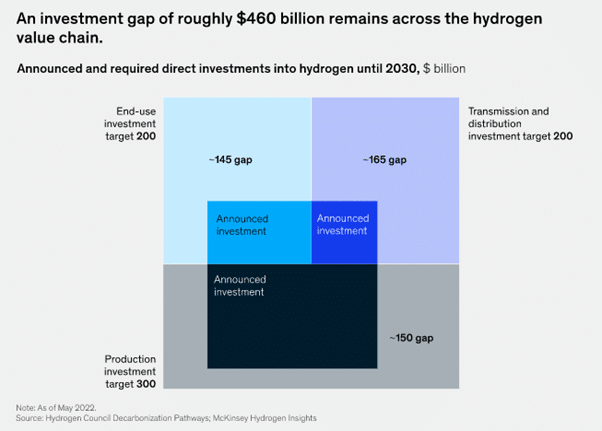Hydrogen Infrastructure: Development and Challenges
24 May 2023 – by Eric Koons
The hydrogen market and associated hydrogen infrastructure have grown significantly in recent years, with increasing interest in the hydrogen economy from governments, investors and companies looking to achieve their decarbonisation goals. As a clean and versatile energy carrier, hydrogen is expected to play a significant role in achieving global decarbonisation efforts and meeting 2050 net-zero targets.
However, the current state of hydrogen infrastructure is not ready to support this vision. The lack of production, storage, transportation and distribution facilities poses a significant challenge to the widespread adoption of hydrogen energy as a mainstream energy source. Therefore, while it is important to invest in R&D to drive down production costs, it is equally important to develop infrastructure.
Infrastructure is critical in developing a robust and reliable hydrogen supply chain that can meet the growing demand for clean energy in the future.

What Are the Infrastructure Needs for Hydrogen?
The hydrogen supply chain comprises production, transport, storage and use. Hydrogen production requires specialised facilities in locations with access to water and renewable electricity and a connection to local transportation networks.
Distribution can occur via shipping and pipelines. Shipping requires significant infrastructure, including hydrogen-equipped ports, vessels and trucks. Additionally, hydrogen is typically compressed before transport to reduce volume. This requires high-powered compressors and storage containers. Hydrogen pipelines are similar to natural gas pipelines, and there is the potential to repurpose existing pipelines for hydrogen.

Use requires developing hydrogen fueling stations in strategic areas with high demand.
A comprehensive refueling infrastructure system that caters to all aspects of hydrogen fuel production, transportation and use is essential for the growth and sustainability of the global hydrogen market. Well-developed hydrogen infrastructure will promote efficiency and reduce end-user costs, increasing adoption.
Fuel Cells and Hydrogen Fueling Infrastructure
This infrastructure system is already present on a small scale, which shows that the system is viable. One example is hydrogen fuel cell vehicles (FCVs) and their refuelling stations. FCVs have been deployed for public use, with more than 160 hydrogen stations globally.
These hydrogen stations work by compressing hydrogen gas into a high-pressure tank and dispensing it into the vehicle’s fuel tank. The refuelling process takes about 3-5 minutes, like conventional gasoline or diesel-powered vehicles. FCVs emit only water vapour and do not produce harmful greenhouse gases.
What Are the Challenges Facing Hydrogen Infrastructure Development?
The development of hydrogen infrastructure faces several significant challenges. Firstly, the infrastructure must handle high pressure to store and transport hydrogen, which can be costly and challenging to implement. For example, hydrogen is compressed to over 700 bar for transportation. This requires specialised compressors and substantial storage containers.
Hydrogen Production Costs
Secondly, cost is a major challenge in developing hydrogen infrastructure. Hydrogen production, storage and transportation are still expensive compared to traditional energy sources. Although hydrogen costs will decrease over time, the initial investment required to develop hydrogen infrastructure can be prohibitive.

Thirdly, current technology is not ready for large-scale hydrogen deployment. For example, electrolysers used to produce green hydrogen from renewable energy sources are not yet efficient enough or produced at scale to be economically viable.
Finally, leaking and durability are also critical issues that must be addressed. Hydrogen is a highly flammable gas that can leak from pipelines or storage tanks, creating safety concerns and increasing maintenance costs. Ensuring the durability of hydrogen infrastructure is critical for reducing costs and improving safety for the end user.
Green Hydrogen Is Necessary for the Future
Investing in the hydrogen economy is a challenging and expensive venture, but it is also a necessary one. The transition towards a low-carbon economy is crucial to mitigate the effects of climate change and reduce carbon dioxide emissions. Hydrogen fuel cells have the potential to play a significant role in this transition by providing a clean and sustainable energy source for transportation and power generation.
Despite the challenges, governments and private companies worldwide are increasing investment in the research and development of hydrogen technologies, recognising hydrogen’s potential as a vital component of the future energy mix.
The potential benefits of an efficient green hydrogen network are enormous, including lower greenhouse gas emissions, getting rid of fossil fuels, better air quality and energy security. As we move towards a cleaner, greener future, investing in hydrogen technologies will be vital in achieving our climate goals and creating a more sustainable world for future generations.
by Eric Koons
Eric is a passionate environmental advocate that believes renewable energy is a key piece in meeting the world’s growing energy demands. He received an environmental science degree from the University of California and has worked to promote environmentally and socially sustainable practices since. Eric’s expertise extends across the environmental field, yet he maintains a strong focus on renewable energy. His work has been featured by leading environmental organizations, such as World Resources Institute and Hitachi ABB Power Grids.
Read more


